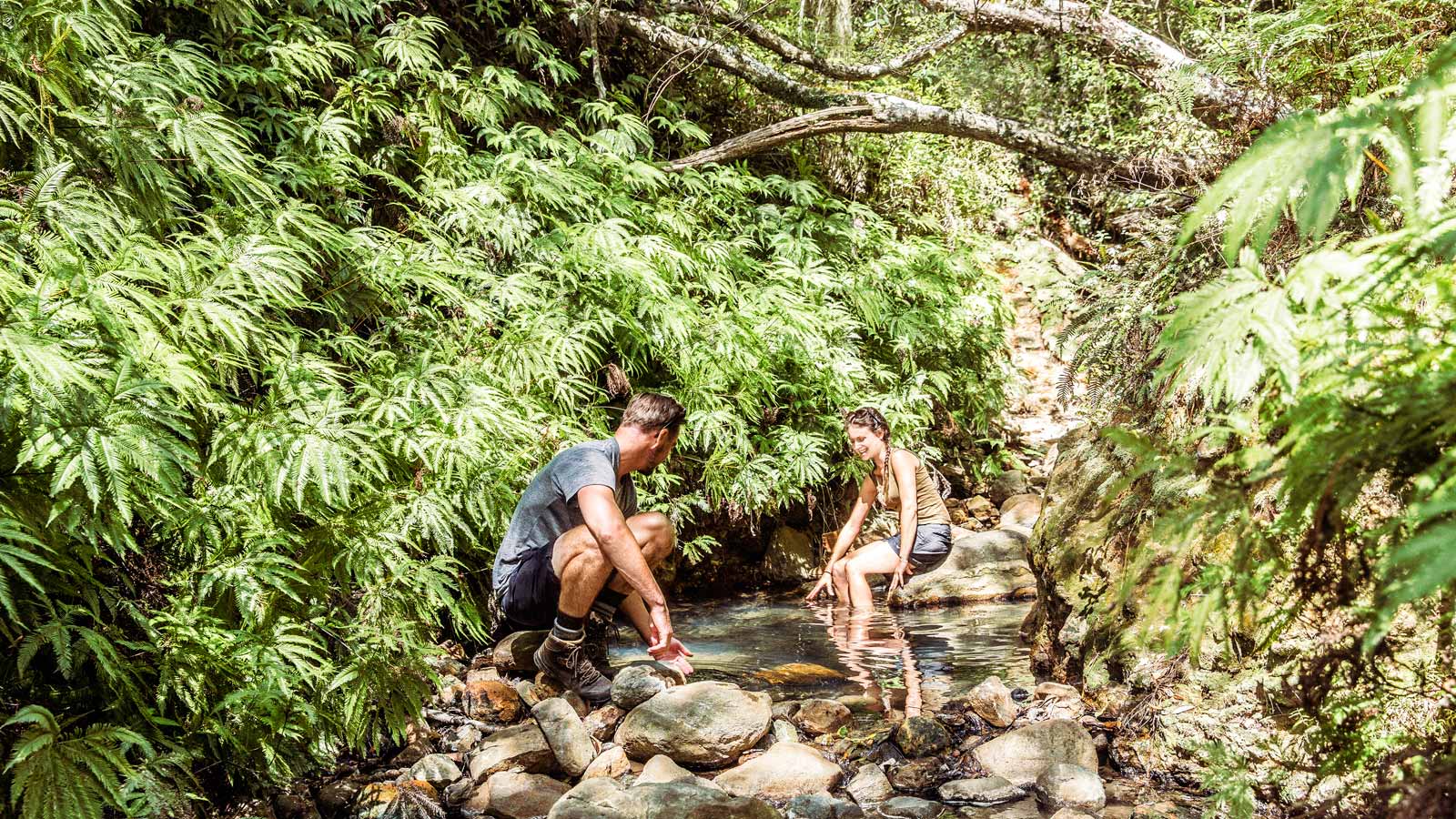Incredible scenery, pristine fresh air, space to let your mind unwind from everyday stresses – go beyond the road for a taste of New Zealand’s unique wilderness areas. With more than 8 million hectares preserved in the national park system – featuring 12,000 kilometres of walking tracks and 1,000 huts for overnight stays – your clients will need to don a pair of hiking boots to explore the most pristine corners of New Zealand. Trails range from short scenic walks to multi-day hikes, ice or mountain climbs for the experienced. Visitors can explore independently, or join a guided tour or walk – a good option for those less experienced in the outdoors and those wanting to try a more intense trekking experience. Taking the hassle out of organising food and transport, they also offer the advantage of an experienced escort who can explain local features and wildlife.
No visit to New Zealand is complete without taking a walk in an unspoilt landscape. There are great opportunities for visitors to get back to nature within minutes of any town. A huge variety of short and medium-length walks are accessible by road, and some trails provide access for disabled visitors. Encourage your clients to go beyond the road and experience New Zealand’s unique wilderness areas.
What’s On Offer
Guided Walks
Guided walks are a great option for visitors less experienced in the outdoors and those seeking a more intense trekking experience. Taking the hassle out of organising food and transport, they also offer the advantage of an experienced escort who can explain local features and wildlife. Maori guides give another level of insight into the spiritual, medicinal and historical aspects of the land, while luxury tours offer the comfort of staying in exclusive lodges and not having to carry a backpack. Walking and hiking operators to look for include:
Abel Tasman Tours & Guided Walks (Nelson) www.abeltasmantours.co.nz
Banks Peninsula Track (Akaroa) www.bankstrack.co.nz
Encounter Guided Day Walks (Queenstown) www.ultimatehikes.co.nz
Guided Nature Walks (Queenstown) www.nzwalks.com
Hollyford Track (Queenstown) www.hollyfordtrack.com
Kahurangi Guided Walks (Takaka) www.kahurangiwalks.co.nz
Orokonui Ecosanctuary (Dunedin) www.orokonui.org.nz
Wilderness Guides (Picton) www.wildernessguidesnz.com
Walking Independently
Walking independently is a great way for your clients to explore the stunning scenery at their own pace, tailoring the journey to their personal preferences. It is better suited to those who have hiking experience, however. If your clients are going independently, they should take care with planning and seek advice before setting out, especially when attempting an overnight walk. They must make sure that the walk is suitable for their fitness. Food, water, emergency gear and warm, waterproof clothing should always be carried – the weather can change quickly in New Zealand. Recommend that your clients visit a Department of Conservation (DOC) Information Centre in the area they intend to walk to seek assistance and to register their departure and plans.
Pass on these important tips:
- Get advice on weather conditions – see www.metservice.co.nz for up-to-date forecasts.
- For safety’s sake, don’t go hiking alone.
- Register your plans at a DOC office before you leave.
- Stick to the track to protect fragile plants.
- Wear a good pair of boots that support the ankles.
- Drink plenty of water to avoid dehydration – water from streams must be purified by boiling for at least three minutes or by using chemical purifiers.
- Wear sunscreen – the sun can be intense even when the weather is cold.
- Take a first-aid kit containing something to soothe blisters – just in case!
- Carry gear in a backpack that fits comfortably.
New Zealand’s Great Walks
The best-known hiking trails are New Zealand’s Great Walks. Administered by the Department of Conservation, these popular trails are maintained to a high standard.
Bookings are required during the summertime peak season for the Milford, Routeburn and Kepler Tracks, and year-round for the Lake Waikaremoana, Heaphy and Abel Tasman Coastal Tracks. All walkers must purchase a Great Walk Pass or Great Walk tickets in order to use hut and campsite facilities along the trail.
- Abel Tasman Coast Track Perhaps the most gentle of the Great Walks – and certainly one of the most popular! – this 60-kilometre coastal track introduces walkers to an intriguing blend of native coastal forest and sandy beaches.
- Heaphy Track This popular track passes through a diverse range of landscapes in Kahurangi National Park, from alpine tussock meadows to West Coast rainforest.
- Kepler Track Located in Fiordland National Park, this 60-kilometre track offers a varied landscape of forest, alpine areas and a glacial valley, and can be walked in three or four days.
- Lake Waikaremoana Discover the remote and wild beauty of the Ureweras on a three- to four-day walk through dense rainforest along the shores of Lake Waikaremoana.
- Milford Track New Zealand’s most widely known walk is located in Fiordland National Park, where forested valleys abound. Walk independently or join a guided group.
- Rakiura Track Located on Stewart Island, in New Zealand’s newest national park, this coastal track can be walked in three days.
- Routeburn Track This popular track links Mount Aspiring and Fiordland National Parks, passing waterfalls, pristine native forest and lakes along the 33-kilometre journey.
- Tongariro Northern Circuit This remarkable trail passes through an unforgettable range of otherwordly volcanic landscapes as it winds around Mount Ngauruhoe in the Ruapehu region.
- Whanganui Journey Travelled by canoe rather than by foot, the Whanganui Journey is grouped with the Great Walks due to its significance as a national treasure. Visitors can rent a canoe and set out on an independent, multi-day river adventure.
Preparation
Bookings are required during peak season for the Milford, Routeburn and Kepler Tracks, and year-round for the Lake Waikaremoana, Heaphy and Abel Tasman Coastal Tracks. Book at www.doc.govt.nz or email greatwalksbookings@doc.govt.nz.
Fees All walkers must purchase a Great Walk Pass or Great Walk tickets to use hut and camp facilities. Maximum stays apply.
On The Trail
If you’re planning a multi-day walk for your clients, you’ll need to arrange overnight stays. Main tracks, such as Whirinaki in the north, and Abel Tasman, Queen Charlotte, Routeburn, Milford and Hollyford in the south, offer accommodation. Less well-known walks may have basic huts for overnight stays. The Great Walks have huts along the way that offer cold water, toilets and heating fuel during peak season from (24 October to 30 April). During that time maximum stay periods apply: look online at www.doc.govt.nz. The key to ensuring your clients get the most out of their experience is research. After practicalities and equipment are arranged, suggest they read a little bit about New Zealand’s native flora and fauna so they know what to look out for along the way.
Urban Exploration
Exploring on foot is as easy as hitting the streets. Your clients can discover waterfront walkways or delve into history on a heritage walk to explore the region’s historic architecture. Look for writers’ walks and ghost walks for a different take on local culture.
Your clients may like to take a stroll in one of the gorgeous parks and gardens that thrive in New Zealand’s temperate climate:
Hamilton Gardens (Hamilton) Six fascinating themed gardens, from a Chinese Scholar’s Garden to an Italian Renaissance Garden.
Pukekura Park (New Plymouth) A Garden of National Significance, it boasts 52 hectares of native forest and is adjacent to the natural amphitheatre of Brooklands Park.
Fitzherbert Park (Palmerston North) Alongside the Manawatu River and home to Dugald MacKenzie Rose Garden, voted one of the world’s top five rose gardens in 2003.
Christchurch Botanic Gardens (Christchurch) Home to a magnificent collection of over 10,000 native and exotic plant species.
Dunedin Botanic Gardens (Dunedin) New Zealand’s oldest botanic gardens, established in 1863 features an aviary that houses native and exotic bird species.
Dunedin Chinese Garden (Dunedin) An authentic Chinese garden, prefabricated in Shanghai.

